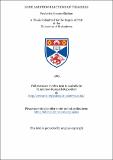Files in this item
Some addition reactions of thiazoles
Item metadata
| dc.contributor.advisor | Reid, D. H. | |
| dc.contributor.author | Skelton, Frederick Stevens | |
| dc.coverage.spatial | 180 p. | en_US |
| dc.date.accessioned | 2018-07-05T13:40:41Z | |
| dc.date.available | 2018-07-05T13:40:41Z | |
| dc.date.issued | 1965 | |
| dc.identifier.uri | https://hdl.handle.net/10023/14999 | |
| dc.description.abstract | Possible synthetic approaches to the pyrrolo[2,1-b]thiazole system have been investigated involving the mode of addition of thiazoles to dimethyl acetylenedicarboxylate. A number of thiazoles were allowed to react with the ester and the reactions were found to be remarkably solvent dependent. Dimethylformamide and methanol (or acetonitrile) were found to be specific for the formation of a particular class of adduct. The structures of the various adducts were extensively investigated by proton magnetic resonance spectroscopy. It was found that the proton magnetic resonance spectra of the unsubstituted and monosubstituted thiazole adducts, prepared in dimethylformamide, were different from the resonance spectra of the 2,4-disubstituted thiazole adducts. Various compounds were prepared for use as proton magnetic resonance reference compounds giving strong support for the structures proposed. Various degradative methods were employed in order to gain additional evidence for the proposed structures. Trimethyl pyrrolo[2,1-b] thiazole-5,6,7-tricarboxylate v/as isolated in low yield from thiazole and dimethyl acetylenedicarboxylate in methanol. Various attempts to decarboxylate the 6-carboxylic acid and isolate the parent pyrrolo[2,1-b] thiazole in good yield were unsuccessful. The 6-carboxylic acid methyl ester was reduced to 6-methyl-pyrrolo[2,1-b] thiazole with the lithium aluminium hydride/aluminium chloride complex. 2-Methylthiazoliiie formed isolable adducts with dimethyl acetylenedicarboxylate but the proton magnetic resonance spectra showed that they possessed a different structure from the corresponding 2-methylthiazole adducts. Thiazoles did not react with ditetrahydropyranyl acetylene-dicarboxylate nor with a saturated solution of acetylene in N-methyl-2-pyrrolidone. The addition reactions of thiazoles were extended to methyl propiolate which was found to be less reactive than dimethyl acetylenedicarboxylate. Adducts could only be isolated in low yield from thiazole, 2,4-dimethylthiazole and 2-methylthiazole. The structures proposed for these adducts did not bear analogy to those isolated from dimethyl acetylenedicarboxylate. Further investigations into the preparation of pyrrolo[2,1-b] thiazoles were attempted using other methods. Low yields of 6-substituted pyrrolo[2,1-b] thiazoles were obtained from the cyclisation of acetonyl and phenacyl-2-alkylthiazolium salts in aprotic solvents. Attempted cyclisations of 3-acetonyl-2-niethyl-thiazolium perchlorate with thionyl chloride and 3-formylmethyl-2-methylthiazolium chloride with sodium acetate and acetic anhydride gave only traces of the corresponding pyrrolo[2,1-b]thiazoles. | en_US |
| dc.language.iso | en | en_US |
| dc.publisher | University of St Andrews | |
| dc.subject.lcc | QD305.T45S6 | |
| dc.subject.lcsh | Thiols | en |
| dc.title | Some addition reactions of thiazoles | en_US |
| dc.type | Thesis | en_US |
| dc.contributor.sponsor | University of St Andrews | en_US |
| dc.type.qualificationlevel | Doctoral | en_US |
| dc.type.qualificationname | PhD Doctor of Philosophy | en_US |
| dc.publisher.institution | The University of St Andrews | en_US |
This item appears in the following Collection(s)
Items in the St Andrews Research Repository are protected by copyright, with all rights reserved, unless otherwise indicated.

